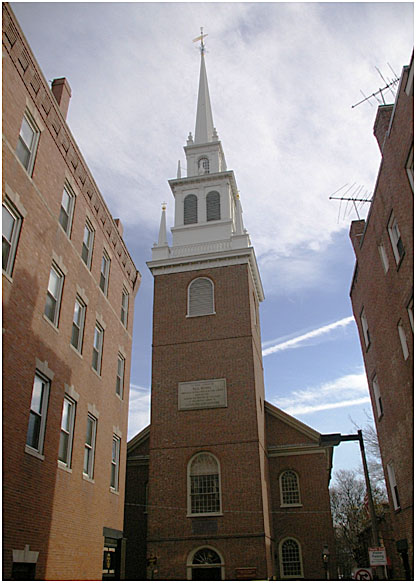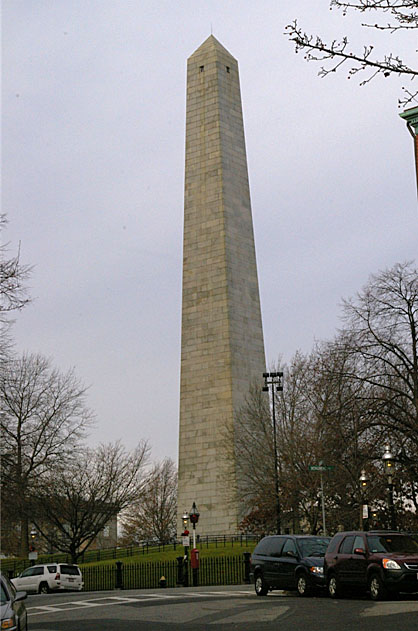Tales of the Itinerant Sailor
Cruising 2008
The Landlubber's Tale
By
"One if by Land, Two if by Sea"
Several months
ago I shared with family and friends my travels across the United States by
automobile last year over Thanksgiving through New Year’s.
I didn’t include photos as I had yet to download them from the camera.
Now that I have the photos, have enjoyed the memories they brought back,
I want to change the story.
The first
story was woven around going to new places while visiting nice people I don’t
see very often. Aside from the
warm, fuzzy feeling one gets while visiting family and friends, I really enjoyed
seeing sights/sites--some for the very first time.
 |
|
New
England Coastal Scene. |
As I embellish
this story, I am relying on memory and the internet.
Not the best combination, I know.
Disclaimers aside, let’s start with Boston.
Oppressive
Taxation
As a student
of history, Boston has always held a special interest for me.
Of all the dissatisfaction within the colonies with the rules and
regulations imposed by the British after
There has been
much conjecture, explanations and theories of why this is so, researched by
well-educated historians much more erudite than I.
I could easily advance my own.
But when all is said and done, we would have just another theory.
 |
|
Old
South Meeting Hall and Boston Skyline |
Boston is
where the first blood was spilt due to growing colonial resistance against
British rule. Parliament had imposed
a series of taxes on the colonies to help pay for the costly French and Indian
War. The colonists balked.
Aside from the monetary issues, the colonists protested a tax imposed by
a Parliament in which they had no representation.
“No taxation without representation!”
What a concept.
The Boston
Massacre
As the
resistance increased against these taxes, and to protect Loyalist interest, the
British military command sent troops to Boston in 1768, some of whom were
quartered in the homes of local citizens, with or without their permission.
Now we have another issued that agitated the locals.
This agitation culminated on March 5, 1770 when a crowd began throwing
snowballs at a British sentry in front of the Custom House on State Street in
Boston. Back up support was called
in; shots were fired; and five Bostonians died.
Thus, the Boston Massacre.
Protests were heard throughout the colonies and, some say, around the world.
Public opinion
was further incensed after the scene of this event was engraved by a silversmith
by the name of Paul Revere, which seemed to depict a British firing squad firing
point blank into a group of civilians.
This production, and later as
a courier for now what is being called the Revolutionary Cause, brought Paul
Revere into close contact with the real firebrands of this movement, John
Hancock and Samuel Adams (that’s right, the beer guy).
The Committees
of Correspondence
Communication
played a decisive role. Colonial
legislatures had appointed Committees of Correspondence during the 1760’s and
charged them with staying in touch with their counterparts throughout the
colonies. Obviously we are talking
about a hand written medium, not quite up to the speed of cell phones, text
messages and e-mail! The first
revolutionary use of these committees occurred in Boston, as you might have
guessed, on November 2, 1772 at a town meeting where it was voted to establish a
sub-committee “to state the Rights of the Colonists and of this Province in
particular” to the other towns and colonies.
Revolutionary talk, eh?
The Boston Tea
Party
This Boston
committee is accredited with organizing resistance to the Tea Act of 1773, the
only remaining import tax imposed by Parliament to help pay for the French and
Indian War. The British had
developed a scheme by which the struggling East India Company was granted a
monopoly to import tea to America, at a lower cost to the colonies as the import
duty was also reduced. Ships loaded
with tea for the colonies arrived subsequently in Philadelphia, New York,
Charleston and Boston. The lower
price was not an enticement; the colonists held firm.
No tea was off loaded (except in one instance where the tea was placed in
a warehouse where it remained until the end of the Revolutionary War).
But only in Boston was there a radical reaction.
After a mass meeting in the Old South Meeting House, it was decided that
about 200 of the men would dress up like Indians, board the three ships, and
throw the tea overboard. Which they
did, with no loss of life on either side, in part due to a well-organized
colonial plan and the capitulation of the merchants, who did not want their
ships to be vandalized. This really
pissed off the British, who closed the Boston Harbor to all merchant ships.
The British are Coming!
 |
|
Statue of folk
hero Paul Revere. |
The people of
Massachusetts had begun to organize militias, for security purposes they say,
and to establish store houses for weapons:
Ammo dumps. In April 1775 the
British military command decided to raid the militia’s arsenal in nearby Concord
and to arrest the radical instigators Samuel Adams and John Hancock in
Lexington.
Anticipating
this, Paul Revere had put together a plan, with the cooperation of the sexton of
the Old North Church (Christ Church).
From the church’s steeple a signal would be sent by lantern to the
colonists across the river in Charlestown as to the movements of British
regulars: One lantern if the army
was moving by land; two lanterns would signal that the army was crossing the
Charles River first. From here, Paul
Revere, William Dawes and, later, Samuel Prescott would ride off into the night
to warn the villagers of this troop movement.
Along the way there were detained and only William Dawes made it all the
way to Concord.
But it is primarily Paul Revere’s name that is associated with this event. Why is this so? Because his home in Boston is still standing? Because it was his plan? Or is it because of the multi-verse poem penned by Henry Wadsworth Longfellow in 1860, on the eve of America’s second great battle, the Civil War? Probably the latter, but at any rate the skirmishes between colonists and British regulars along the way and in Lexington and Concord become the first battles of the American Revolution. And for a fee you can visit Paul Revere’s house in Boston. Or you can click on the internet and read the entire poem for free.
|
Listen my children, and
you shall hear Of the midnight ride of Paul Revere. On the eighteenth of April, in Seventy-five; Hardly a man is now alive Who remembers that famous day and year. |
 |
|
Looking for the
two lanterns hanging
“aloft in the belfry arch of Christ’s Church”—The Old North Church. |
The Battle of
Bunker Hill
 |
|
“Don’t fire
until you can see the whites of their eyes.” At the Battle of Breed’s Hill, an American commander is quoted in order
to preserve what little gunpowder the colonists had. |
And this
begins the siege of Boston by British troops.
Colonial resistance forces were organizing from Massachusetts to the
Carolinas. In Boston British troops
under the command of Major-General William Howe wanted command of the high
ground of the city, especially Breed’s Hill (not Bunker Hill).
Learning of this, colonialists under the command of General Israel Putman
stealthily fortified both hills.
When the British mounted their attack, they were met by strong resistance.
Eventually, the British were victorious but at great expense, suffering
more casualties than any of the remaining battles in the years to come before
their final surrender in Yorktown, Virginia in 1781.
This misnamed battle, in effect, becomes the first battle of the American
Revolution.
So?
All of this in
order to postulate a question: Are there
injustices in our communities today that would prompt this same commitment to
resist authority, to organize and to take action?
A call to action? That would
cause us to take up arms (metaphorically speaking, of course) against those
causing the unjust treatment, whether they be in positions of authority of not?
To join a Tea Party? Think
about it as you down your first cup of coffee or sip your cocktail at pool side.
Well, enough
about history. Let’s get on with the
trip. Obviously, still by land.
| Changes at Rio Dulce | New York |
Cruising 2008: The Landlubber's Tale
Copyright © 2009 Steven Jones. All Rights Reserved.
Contact: siriusii@hotmail.com